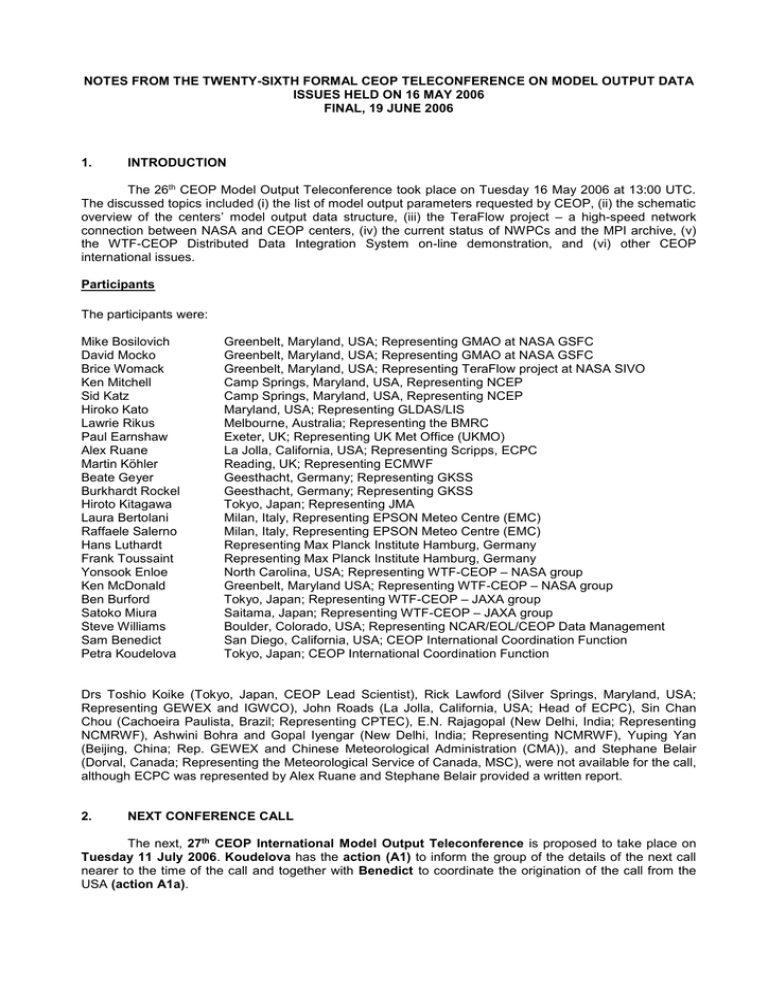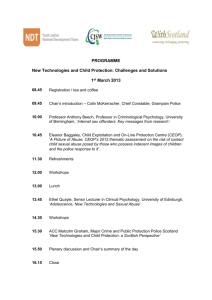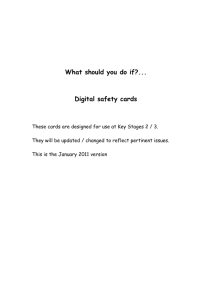NOTES FROM THE TWENTY-SIXTH FORMAL CEOP TELECONFERENCE ON MODEL OUTPUT... ISSUES HELD ON 16 MAY 2006
advertisement

NOTES FROM THE TWENTY-SIXTH FORMAL CEOP TELECONFERENCE ON MODEL OUTPUT DATA ISSUES HELD ON 16 MAY 2006 FINAL, 19 JUNE 2006 1. INTRODUCTION The 26th CEOP Model Output Teleconference took place on Tuesday 16 May 2006 at 13:00 UTC. The discussed topics included (i) the list of model output parameters requested by CEOP, (ii) the schematic overview of the centers’ model output data structure, (iii) the TeraFlow project – a high-speed network connection between NASA and CEOP centers, (iv) the current status of NWPCs and the MPI archive, (v) the WTF-CEOP Distributed Data Integration System on-line demonstration, and (vi) other CEOP international issues. Participants The participants were: Mike Bosilovich David Mocko Brice Womack Ken Mitchell Sid Katz Hiroko Kato Lawrie Rikus Paul Earnshaw Alex Ruane Martin Köhler Beate Geyer Burkhardt Rockel Hiroto Kitagawa Laura Bertolani Raffaele Salerno Hans Luthardt Frank Toussaint Yonsook Enloe Ken McDonald Ben Burford Satoko Miura Steve Williams Sam Benedict Petra Koudelova Greenbelt, Maryland, USA; Representing GMAO at NASA GSFC Greenbelt, Maryland, USA; Representing GMAO at NASA GSFC Greenbelt, Maryland, USA; Representing TeraFlow project at NASA SIVO Camp Springs, Maryland, USA, Representing NCEP Camp Springs, Maryland, USA, Representing NCEP Maryland, USA; Representing GLDAS/LIS Melbourne, Australia; Representing the BMRC Exeter, UK; Representing UK Met Office (UKMO) La Jolla, California, USA; Representing Scripps, ECPC Reading, UK; Representing ECMWF Geesthacht, Germany; Representing GKSS Geesthacht, Germany; Representing GKSS Tokyo, Japan; Representing JMA Milan, Italy, Representing EPSON Meteo Centre (EMC) Milan, Italy, Representing EPSON Meteo Centre (EMC) Representing Max Planck Institute Hamburg, Germany Representing Max Planck Institute Hamburg, Germany North Carolina, USA; Representing WTF-CEOP – NASA group Greenbelt, Maryland USA; Representing WTF-CEOP – NASA group Tokyo, Japan; Representing WTF-CEOP – JAXA group Saitama, Japan; Representing WTF-CEOP – JAXA group Boulder, Colorado, USA; Representing NCAR/EOL/CEOP Data Management San Diego, California, USA; CEOP International Coordination Function Tokyo, Japan; CEOP International Coordination Function Drs Toshio Koike (Tokyo, Japan, CEOP Lead Scientist), Rick Lawford (Silver Springs, Maryland, USA; Representing GEWEX and IGWCO), John Roads (La Jolla, California, USA; Head of ECPC), Sin Chan Chou (Cachoeira Paulista, Brazil; Representing CPTEC), E.N. Rajagopal (New Delhi, India; Representing NCMRWF), Ashwini Bohra and Gopal Iyengar (New Delhi, India; Representing NCMRWF), Yuping Yan (Beijing, China; Rep. GEWEX and Chinese Meteorological Administration (CMA)), and Stephane Belair (Dorval, Canada; Representing the Meteorological Service of Canada, MSC), were not available for the call, although ECPC was represented by Alex Ruane and Stephane Belair provided a written report. 2. NEXT CONFERENCE CALL The next, 27th CEOP International Model Output Teleconference is proposed to take place on Tuesday 11 July 2006. Koudelova has the action (A1) to inform the group of the details of the next call nearer to the time of the call and together with Benedict to coordinate the origination of the call from the USA (action A1a). 3. MODEL OUTPUT DATA GROUP GENERAL ISSUES 3.1 Opening (3.1a) Benedict welcomed everyone on the call and introduced the agenda as well as the reference material distributed prior to the call that included: (i) Notes from the last call on 28 March 2006; (ii) the list of model output parameters requested by CEOP that had been included on the original request to the Centers in 2001, (iii) the schematic overview of the centers’ model output data structure prepared by the MPI team (see Attachment 1), (iv) the proposal of the NASA Goddard Software Integration and Visualization Office (SIVO) to collaborate with the TeraFlow project to establish a high-speed network connection between NASA and the CEOP centers (see Attachment 2), and (v) the updated status table of the CEOP model output data base at MPI (see Attachment 3). 3.2 List of model output parameters required by CEOP (3.2a) Mitchell reiterated that the list of key parameters required by CEOP had been prepared for Phase 1 several years ago and thus it might be desirable to revise it. During the ensuing discussion on this topic additional variables were suggested be included in the CEOP model output data sets. The list of the additional variables include: 1. 2. 3. 4. 5. 6. 7. 8. 9. 10. - Total cloud cover (fraction) Total cloud condensate (sum of liquid and frozen, for each model layer) Total cloud liquid condensate (liquid, not frozen, for each model layer) Individual species of cloud frozen condensate (e.g., graupel, etc., for each model layer), if the given model's cloud microphysics predicts individual cloud ice species as state variables (namely, what cloud ice species are provided from the model's cloud microphysics to the model's shortwave and/or longwave radiation physics) Total convective heating rate (for each model layer) Shallow convective heating rate (for each model layer) Deep convective heating rate (for each model layer) Total convective moistening rate (for each model layer) Shallow convective moistening rate (for each model layer) Deep convective moistening rate (for each model layer) Note 1: #2 and #3 should be defined such that subtracting #3 from #2 yields the total cloud frozen condensate (non-liquid). Note 2: #5, #6, #7 should be defined such that #5 equals the sum of #6 and #7, hence it is sufficient to give any two of these three items. Note 3: #8, #9, #10 should be defined such that #8 equals the sum of #9 and #10, hence it is sufficient to give any two of these three items. (3.2b) In this context, all of the Center spokespersons including Belair, Bosilovich, Kato, Mitchell, Katz, Ruane, Roads, Chou, Earnshaw, Köhler, Bertolani, Salerno, Rockel, Geyer, Rajagopal, Kitagawa, and Rikus were asked to consider including the above parameters into their output files provided to the CEOP database at MPI during Phase 2 (action A2). 3.3 Schematic overview of the Centers’ Model Output Data structure (3.3a) Toussaint introduced the schematic overview of the Centers’ data structure that was distributed prior to the call (see Attachment 1). The document shows what MOLTS and what gridded output data in terms of a free forecast vs. analysis/assimilation each center provides to MPI and it reveals a significant inhomogeneity of the data that must be taken into account in model intercomparisons. Toussaint also explained issues associated with homogenization of the Centers’ data sets that are being uploaded to the MPI database. He suggested that additional guidelines for the data structure be identified for CEOP Phase 2 in order to facilitate and expedite the data uploading procedure. The participants appreciated the special effort of the MPI team to assemble the document and acknowledged the usefulness of the overview that provide for the first time a clear and comprehensive summary of the data that the centers are contributing to CEOP. (3.3b) Mitchell pointed out that NCEP was intentionally providing only the free forecast data for MOLTS in compliance with their understanding of the purpose of the MOLTS data, which was evaluation of the model physical processes with respect to the in-situ observations. On the other hand, some of the other Centers provide both the free forecast and the data from the analysis/assimilation cycle. Mitchell highlighted that currently, only the analysis/assimilation step (time 00) and the first forecast step (time 06) MOLTS data were accessible by the WTF-CEOP system. He voiced that this data was not suitable for model physics evaluation and intercomparison and suggested that the free forecast output be made accessible for the WTF-CEOP system as soon as practicable. In this regard, Toussaint explained that the user requirements differed between those, who dealt with model evaluation and intercomparison studies, and those focusing on climate/water cycle research. Whereas the former are interested in data blocks of one model initialization with its different forecast steps, the latter mainly need analysis/assimilation time series. Toussaint mentioned that at the 4th CEOP Implementation Planning Meeting in Tokyo, March 2005, it had been proposed and agreed to begin with the analysis/assimilation time series because water and energy cycle research was a key CEOP objective. He added that with the help of GKSS, the MPI/WDC-Climate planned to offer the MOLTS data in the NetCDF format for downloading. In this case, one file would contain all parameters, forecast steps and levels of one model's initialization (run). More details about the data structure at the MPI database are provided in the CEOP Newsletter #9 issued in February 2006. (3.3c) Mitchell also suggested that a longer-term (2-day) free forecast output for MOLTS be contributed to CEOP in Phase 2 as it would be very useful for model physics evaluation and subsequent improvement. The Center spokespersons including Belair, Bosilovich, Kato, Mitchell, Katz, Ruane, Roads, Chou, Earnshaw, Köhler, Bertolani, Salerno, Rockel, Geyer, Rajagopal, Kitagawa, and Rikus were asked to consider providing a longer-term free forecast MOLTS for Phase 2. 3.4 WTF-CEOP On-line Demonstration (3.4a) As proposed and agreed to at the time of the last call, the on-line demonstration of the WTF-CEOP Distributed Data Integration System (http://jaxa.ceos.org/wtf_ceop/) was performed under the guidance of Ben Burford. Various features and capabilities of the System were shown and their utilization for, for example, a quick visual comparison of in-situ, model, and satellite data was demonstrated. Participants appreciated the introductory session and acknowledged the System and its usefulness for various tasks associated with data analyses. (3.4b) The participants were encouraged to browse the system on their own to explore further features and see more data than it was possible during the limited time on the call. Those, who have not created their user account yet, may wish to do so through the web site: http://ceop.restec.or.jp/auto_pass.html. In case of any difficulties, the applicant should contact Ben Burford and the JAXA WTF-CEOP team by email: benb@restec.or.jp; or rd@restec.or.jp. (3.4c) It was proposed and agreed that similar demonstrations be held during the calls in the future. The demonstrations will be focused on actual scientific issues that are to be specified in advance prior to each call and will manifest how the WTF-CEOP System may be used to support research work. Burford and Mitchell took the action (A3) to prepare the science scenario and the demonstration for the next call. All participants were asked to provide Burford, Mitchell, Benedict, and Koudelova with their suggestions in terms of scientific issues that should be discussed in the near future (action A3a). 3.5 MPI status (3.5a) Luthardt referred to the status overview table that was distributed prior to the call and is attached to this document (see Attachment 3) and mentioned that the work on ingesting the data into the database had been progressing but emphasized that the process of including the data into the database was significantly influenced by the fact that the data were very inhomogeneous across the Centers. Luthardt advised the participants that a new person had join their team, who would focus on data processing. This new development will positively effect on the data process at MPI. 3.6 GKSS, ICTS, and MOLTS data format issues by Beate Geyer and Burkhardt Rockel (3.6a) Rockel reported that regarding the ICTS output of four out of 8 models had been completed for all of the 7 investigated regions for the whole 5-year period of Phase 1 (2001 – 2004). He mentioned that the group had continued with the model output comparisons against reference site datasets and the global model analyses and the study had been accomplished for 5 regions. The two remaining regions include AMMA and MDB, for which the required reference site data sets (e.g. surface fluxes) are not yet available. (3.6b) Rockel further reported that they had begun to carry out 2-D comparisons focusing on precipitation and using the GCPC products. (3.6c) Geyer reported that they had started to transfer the data that had been converted into the NetCDF format to the MPI archive. Geyer also voiced that the list of remaining issues associated with the CF metadata that were found in the Centers’ output files had been provided to the Centers. 3.7 Reference site data update (3.7a) Williams reported that new data from the CAMP and MDB CSEs had been submitted to NCAR/EOL and was undergoing the QC procedure. He also mentioned that they were working on the list of the sites that would participate in CEOP Phase 2 and should finalize the list soon. 3.8 Cloud data (3.8a) Köhler reiterated that Prof Rachel Pinker was willing to cooperate with CEOP and provide the ISCCP cloud cover data. He pointed out that CEOP needed to specify the ISCCP data requirements and introduced his proposal that included: (i) 3-hourly data for 41 CEOP MOLTS locations covering the whole Phase 1 period (2001 – 2004) (ii) 3-hourly global data for a one-month period during a peak season of Asian and American Monsoons, i.e. August 2004 Köhler voiced that Prof Pinker had agreed to provide the data per the proposed request. However, he suggested that the request be discussed and revised by others on the modeling group as well as by other working groups including the satellite data group, the CIMS group, the WESP group, and the reference site data group. To initiate the discussion, Köhler took the action (A4) to prepare a draft request for the ISCCP data and provide it to Benedict and Koudelova, who will distribute it to the concerned persons as suggested (action A4a). 4. CURRENT STATUS OF NWPCs 4.1 BMRC by Lawrie Rikus (4.1a) Rikus reported that he was carrying out test runs of the improved version of their model that might be put into operation in the near future. Subsequently, the period of EOP-3 and EOP-4 will be reprocessed. 4.2 JMA by Hiroto Kitagawa (4.2a) Kitagawa reported that JMA was preparing for contributing their output to CEOP during Phase 2, i.e. 2007 – 2010, but unfortunately would not provide the data for the period 2005 – 2006. Kitagawa mentioned that JMA had made a major upgrade of the computer system recently and it would be extremely complicated to recover the data for the concerned period with the limited resources that were available. 4.3 ECPC by Alex Ruane (4.3a) Ruane reported that they were focusing on scientific issues using the output of other models, in-situ and satellite data for their analyses. He pointed out that regarding the satellite data they were currently looking at global precipitation fields including also non-CEOP products but considered further analyses using more satellite data in the near future. 4.4 GMAO by Mike Bosilovich (4.4a) Bosilovich reported that the GEOS3 data that was available at MPI had been produced several years ago and thus it might not be fully relevant at present. Accordingly, the GMAO team plans to reproduce the GMAO output for the complete period of Phase 1 with the data produced by their new system GEOS5. Bosilovich voice that they would reprocess the whole period and then submit the data all at once. (4.4b) Bosilovich further explained a new strategy adopted in GEOS5 that is remarkably different from the previous version and took the action (A5) to provide schematic diagrams of the modeling system to Koudelova, who will circulate them among the group (action A5a). (4.4c) Bosilovich introduced Dr David Mocko, who had joined the GMAO team and would focus on model intercomparison activities including CEOP Analyses Intercomparison Project. The participants welcomed Dr Mocko on the CEOP Modeling Group and acknowledged his support of CEOP in this matter. 4.5 GLDAS by Hiroko Kato (4.5a) Kato reported that the new, reprocessed MOLTS data of the 1-degree resolution runs had been uploaded to the MPI CEOP database and made available on-line. (4.5b) Kato also mentioned that they were preparing for submitting the gridded output but it had not been decided yet which of the multiple runs would be provided to CEOP. She pointed out that they might provide outputs of more runs including a 0.25-degree resolution simulation, which represented a large volume of data and thus the enhanced data transfer performance as proposed by the TeraFlow project (see section 6.1) would be extremely useful. 4.6 NCEP by Ken Mitchell and Sid Katz (4.6a) Mitchell reiterated that NCEP continued and would continue to provide their model output (forecast) to MPI once per day including both, gridded and MOLTS data, for the years 2005 – 2010. He mentioned that in case of MOLTS, they considered to begin to provide the data in the NetCDF format in January 2007. (4.6b) Mitchell further reported that NCEP would not provide their global reanalysis data for EOP-3 and EOP-4 but they were planning to contribute to CEOP the third NCEP global reanalysis output for Phase 2. 4.7 EPSON Meteo Centre (EMC) by Laura Bertolani and Raffaele Salerno (4.7a) Bertolani reported that they had provided the MOLTS variable name table to Geyer and planned to send a sample of the MOLTS data to Geyer as well as to MPI in a few weeks and a sample of the gridded output to MPI soon after. Bertolani mentioned that they would provide the same output as NCEP did as it was shown in the schematic overview of centers’ data structure prepared by the MPI team (Attachment 1). 4.8 UK Met Office by Paul Earnshaw (4.8a) Earnshaw mentioned that they had found a small error in a certain portion of the UKMO MOLTS data that had been provided to MPI and therefore they would resubmit the corrected MOLTS data for the concerned period, which covered a few months of the year 2004, in the near future. 4.9 ECMWF by Martin Köhler (4.9a) Köhler reported they continued to archive MOLTS for the period 2005 – 2006 and would submit the data in due course. In the meantime, the work on the ECMWF gridded output and conversion of the MOLTS data for EOP-3 and EOP-4 into the CF NetCDF format is also advancing. 4.10 MSC by Stephane Belair (in writing) (4.10a) Belair reported in writing that in cooperation with Geyer they had finalized the ASCII format for the MSC MOLTS data that would be consequently converted by Geyer into the CF NetCDF format. In addition, a sample of the gridded output has been sent to the MPI archive and Belair is anticipating the final confirmation of appropriateness of the MSC GRIB files. Unless the MPI team or Geyer indicates any discrepancies in the respective formats, Belair will begin to process the whole database. Belair mentioned that due to its large volume, the data would be sent on a hard medium, tape or disk, rather then transferred using the FTP procedure. In this context, the MPI team was asked to contact Belair and provide him with their comments on the MSC GRIB files as soon as possible (action A6). 5. DATA INTEGRATION ISSUES 5.1 WTF-CEOP – NASA group (5.1a) McDonald reiterated that the engineering kick-off meeting of the NASA project to build the NASA satellite data access system for CEOP had been held recently and the work on the prototype had been initiated. (5.1b) McDonald further reported that the CEOS WGISS meeting had been held in Budapest, Hungary at the beginning of May that also provided an opportunity to discuss several issues associated with the satellite data access project with key NASA representatives and other partners. 6. OTHER ISSUES 6.1 High-speed network connection between NASA GSFC and the CEOP archives and centers (6.1a) Bosilovich introduced Dr Brice Womack from the NASA Goddard Software Integration and Visualization Office (SIVO), who kindly accepted to attend the call and explain the proposal for cooperation with the TeraFlow project to establish a high-speed network connection between NASA GSFC and the CEOP archives and centers. (6.1b) Referring to the document distributed prior to the call (see Attachment 2), Womack explained that TeraFlow (http://www.teraflowtestbed.net/) was an optical network research project that had an optical network capable of transfer rates of 10Gb/s connecting the existing nodes in Tokyo, Amsterdam, Chicago, and Washington, DC. SIVO is proposing to collaborate with the TeraFlow project to provide the optical backbone between the TeraFlow nodes for the CEOP data transfers. It means that the TeraFlow nodes will serve as forward mirror points for the CEOP centers (e.g. the Tokyo node for CSDIC at the University of Tokyo; the Amsterdam for MPI at Hamburg), which will significantly decrease the number of routers involved in the transfer. In order to optimize the whole system, it is necessary to also increase the performance of the local connections between the CEOP centers and the TeraFlow nodes. SIVO is proposing to investigate the possibilities of improving the transfer rates through the local connections in cooperation with system administrators of respective centers, for which purpose the SIVO team would need to have user accounts at the local CEOP archives. (6.1c) In response to Koudelova’s query about the difference between the previous network optimization efforts that had taken place in recent past and the currently proposed initiative Womack mentioned that the first investigation had focused on monitoring the normal internet connection and reducing the number of “bottlenecks” along the paths between the CEOP archives and NASA Goddard, while the new initiative includes the TeraFlow optical network that would improve the connection performance much more significantly. (6.1d) Several participants emphasized that more efficient data transfer from/to the CEOP archives would be highly desirable referring to their personal experiences with downloads/uploads of voluminous data sets. It was proposed and agreed that competent persons at the CEOP archives be appointed, who would follow up on this initiative with the SIVO team. The MPI and UT teams have the action (A7) to nominate a suitable contact person(s) to cooperate with the SIVO team. Koudelova will prepare an adequate list of names and contact coordinates and provide it to the SIVO team as soon as possible (action A7a). 7. CLOSING Benedict acknowledged the participants for attending the call and providing their valuable contributions, comments and suggestions. The call was adjourned at 15:20 UTC. ATTACHMENT 1 Schematic overview of the Centers’ Model Output Data structure ATTACHMENT 2 Proposal for collaboration with the TeraFlow project to establish a highspeed network connection ATTACHMENT 3 Updated status of the CEOP Model Output Database






